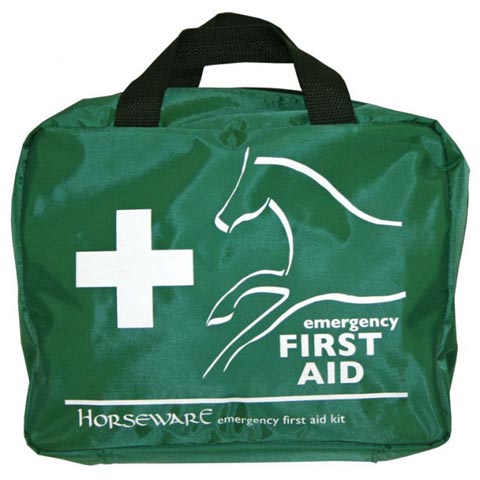
by: Kentucky Horse Council
and first appeared on horse.com
Every horse owner should have an equine first-aid kit in their barn and trailer. There are a variety of equine first-aid kits commercially available, ranging from less than $50 to more than $500. While the expensive kits offer a great deal of diverse treatment options, most horse owners can get by with a more affordable homemade kit for travel.
equine first aid kit
A few things required for an equine first-aid kit: VetWrap, triple antibiotic ointment, disposable diapers, Betadine, and wound care ointment.
The Bucket
The first step in making your own portable first-aid kit is locating a suitable bucket. A 5 gallon bucket with a snap on lid is the best option. If you don’t have a good bucket (with a lid) you may be able to get one from any of several community locations. Many delis, bakeries, and other food producing companies buy supplies (like pickles, frosting, and filling) by the bucket. When the contents of those buckets are used the facility is left with disposal. When you ask for a bucket you may want to specify the size (5 gallons) and that it have a lid. Smaller buckets may also be available and they can be useful for other things. If you cannot find a free bucket you should be able to buy one from a local feed, supply, or tack store.
The bucket serves two purposes: 1. It is a container to hold your first-aid kit items together and keep them clean; 2. It can be emptied and used as a bucket for first-aid purposes like washing wounds. Before you begin assembling your first-aid kit, thoroughly clean and dry your bucket. There should be no residue, lingering scent, or moisture in the bucket.
Filling the Bucket
Supplies for your portable first-aid kit should be carefully selected to fit inside the bucket. Liquid and gel topical medications can be transferred from larger containers into smaller leak proof applicators. Leave the larger containers at home where you have more storage room. Travel shampoo containers work well for both liquids and gels. Small size Tupperware or Rubbermaid type food containers are also handy for holding more solid compounds, and organizing supplies.
Dry Supplies You’ll Need:
* 16″ Combine Bandage
* 4 – 3×4″ Non-stick Telfa Pads
* Vetwrap
* 5 – Wooden Tongue Depressors *
* 4 – 10 cc. Syringes **
* 4×4″ Gauze
* Epsom Salt
* Thermometer
* Stethoscope
* Scissors
* Tweezers/Forceps
* Duct Tape
* 4 – Disposable Diapers ***
* Gloves
* Clean, Small Towel(s)
* Hand Sanitizer
* 2- 6″ Sections of Rubber Tubing ****
* Small Flashlight
Wet Supplies You’ll Need:
* Alcohol Preps OR 4×4″ Gauze in a container with ample Rubbing Alcohol
* Betadine
* Dawn Dish Soap OR Betadine Scrub OR Chlorhexidine Scrub
* Triple Antibiotic Ointment
* 1 Gallon Bottled Water
* Antiseptic Wound Spray
You should talk to your veterinarian about other prescription medications to include in your portable first-aid kit like anti-inflammatories, analgesics, and tranquilizers. Some prescription medication may require special handling and storage and might have to housed in a location other than your handy first-aid bucket. Once the bucket is filled just snap on the lid and you are ready. As you deplete supplies from the kit simply replace them from your barn supply. It is important that you not only carry these items, but also know how to use them. To learn more about providing first-aid care for your horse, talk to your veterinarian or attend a training conducted by a veterinarian.
*Tongue depressors can be used to apply topical medication without contaminating the wound or the medication.
**You probably noticed that this list includes syringes but not needles. For a basic first-aid kit, without any injectable medication, you don’t need needles. The syringes can be used to flush wounds. A 10 cc syringe is especially nice as you can draw up 2 cc of Betadine and then fill the remainder of the syringe with water for safe flushing of punctures and other open wounds.
***Diapers work great for packing hooves and they are very absorbent and can also be used to staunch the blood flow from a seeping wound.
****Rubber tubing can be inserted into the horse’s nostril and secured, to keep the horse’s airway open in the event of snakebite, excessive bee stings, or other bites that cause severe swelling of the face.
